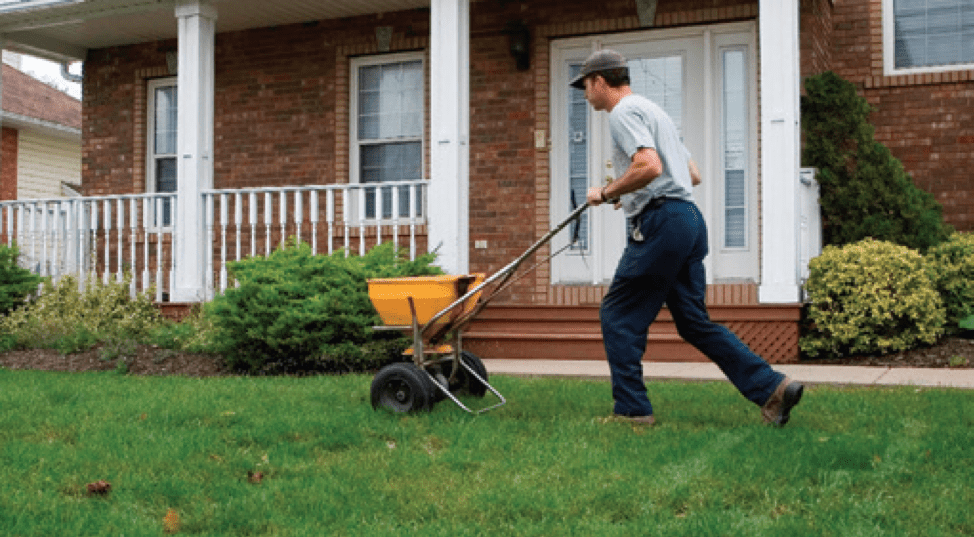
Click Here to View Original Article
How optimum fertilizer selection and application timing can uncover new efficiencies for your lawn care business
It’s no secret that summer can be tough on lawns. Extreme heat, pests, drought — all these things can stress turf and negatively impact both its health and appearance. Now that cooler fall weather has arrived in most parts of the country, it’s the right time to get your customers’ lawns ready for next spring by taking stock of any damage, and applying the right fertilizer.
Fertilizing turf and plants in the fall can help extend color, density and growth through the cooler fall months. It can also help build carbohydrate reserves, enhance winter hardiness, maintain winter color and promote earlier spring green-up. According to Eric Miltner, Ph.D., agronomist for Koch Turf & Ornamental, this is true for both cool-season and warm-season grasses.
“For cool-season grasses, fall may be the single most important time to fertilize,” Miltner said. “For warm-season grasses, potassium (K) fertilization helps build cold hardiness; however, some nitrogen (N) is required to encourage K uptake.” Miltner went on to say that, in many cases, fertilizer can be applied in conjunction with fall pre-emergent or post-emergent weed control, and doing so may even improve the performance of a post-emergent herbicide. “It may seem counterintuitive, but stressed weeds are actually more difficult to control,” he explained. “Healthy weeds tend to take up herbicides more efficiently.”
Timing Is Everything
While fertilizing turf in the fall is certainly a good idea, the proper timing is crucial, particularly for warm-season grasses. Low N rates can be applied to warm-season turf in early fall to extend color and quality, but too much N too late in the season can reduce the turf ’s winter hardiness. However, applying K to warm-season turf can improve cold tolerance. The fertilization window is not as much of a winter hardiness issue with cool-season turf, but there is the risk of poorer nutrient utilization if applied too late.
“Farther north, applications should generally occur in September and October,” Miltner said. “It’s possible to wait until November or December as you move farther south or into the Pacific Northwest with its milder fall temperatures.”
Regardless of turf type, improperly timing your fertilizer applications can be a waste of time and money. And, there’s the chance your customers will notice that their lawns don’t look their best when spring rolls around. That could lead to customer retention issues. “If a customer’s lawn looks great in the spring due to a great fall fertilizer application, he or she will be less likely to look elsewhere for a new lawn care provider,” Miltner explained. “The lawn care business is very competitive, and it’s important to do what you can to keep the customers you have.”
 Advantages of Enhanced Efficiency Fertilizers
Advantages of Enhanced Efficiency Fertilizers
Applying fertilizer at the right time may be very important, but so is the type of fertilizer you apply. Selecting the right product and using it in the right way can ensure optimal performance while minimizing potential risk to the environment. “With so many fertilizers on the market, it can be difficult for lawn care professionals to identify their best options,” Miltner said. “Choosing the right fertilizer makes it possible to provide customers with a solution that both nurtures beautiful, healthy lawns and supports environmentally responsible practices.” Koch Turf & Ornamental, the company for which Miltner works as an agronomist, produces enhanced-efficiency fertilizers (EEFs) that optimize nutrient performance and minimize nitrogen loss. Their goal is to provide products that support consistent plant growth with fewer applications.
“Enhanced efficiency fertilizers just make sense, from both an environmental and an economic perspective,” Miltner added. “By applying a more efficient product, lawn care professionals can achieve better results while optimizing labor and resources. And they can differentiate themselves from their competition by promoting environmental stewardship and contributing to their companies’ bottom lines.”
Miltner said that fall can be a great time to apply an EEF, particularly to cool-season turf; however, there are still variables to consider. Stabilized N products with urease and nitrification inhibitors can help reduce losses due to volatilization, leaching, and denitrification, especially in areas that experience heavier autumn rainfall. The release rates of many slow- or controlled-release fertilizers are temperature dependent, so, depending on the product and the timing of its application, release may begin in the fall, shut down during the cold winter months, and then resume in the spring.
“For example, in Pennsylvania, which has a northern climate, an October application of Koch’s DURATION CR 120 (a four-month polymer-coated urea fertilizer) resulted in a color response that lasted until June 1,” said Miltner. “In that scenario, a lawn care operator could skip their spring fertilizer applications. Time previously spent fertilizing can be used for other services, or simply for making more targeted weed control applications. Think about the opportunities that could arise from having that extra time and labor resource. It may not be for everyone, but for certain businesses, it can provide a big advantage.”
Find Efficiencies, Generate Revenue
The environmental, economic and efficiency benefits of fall fertilization are hard to ignore. They span the fall, winter and spring seasons, and create greener, healthier turf that uses resources more efficiently. So what’s the bottom line? Understand how different fertilizer technologies work, then choose those that best match your climate, your customers’ needs and your business objectives. From there, you can follow best practices when timing your applications — not just in the fall, but all year round.
“If you’re not sure if your current program is really optimal for your customers and your business, contact your local fertilizer distributor,” Miltner added. “The staff there should be able to help you find any previously undiscovered efficiencies. Use any saved resources — time and money, for example — to implement other revenue-generating services to your business. Or use that extra time for tasks like sales or equipment maintenance. The possibilities really are endless.”